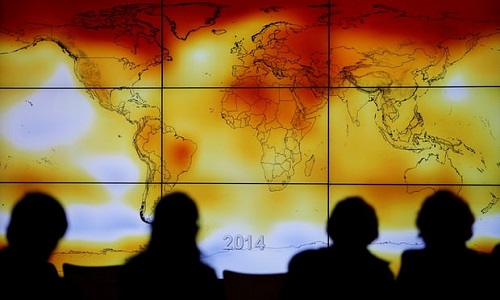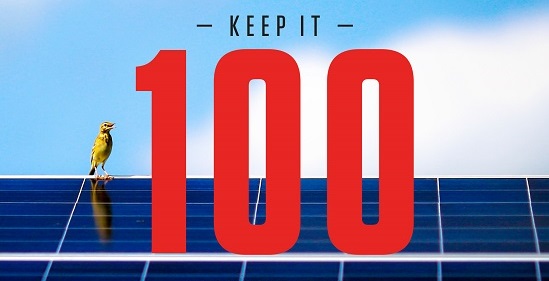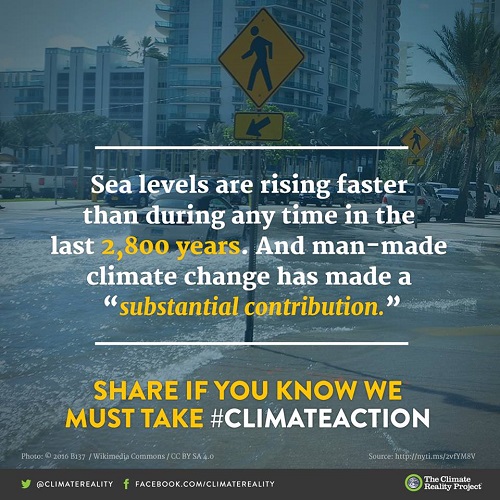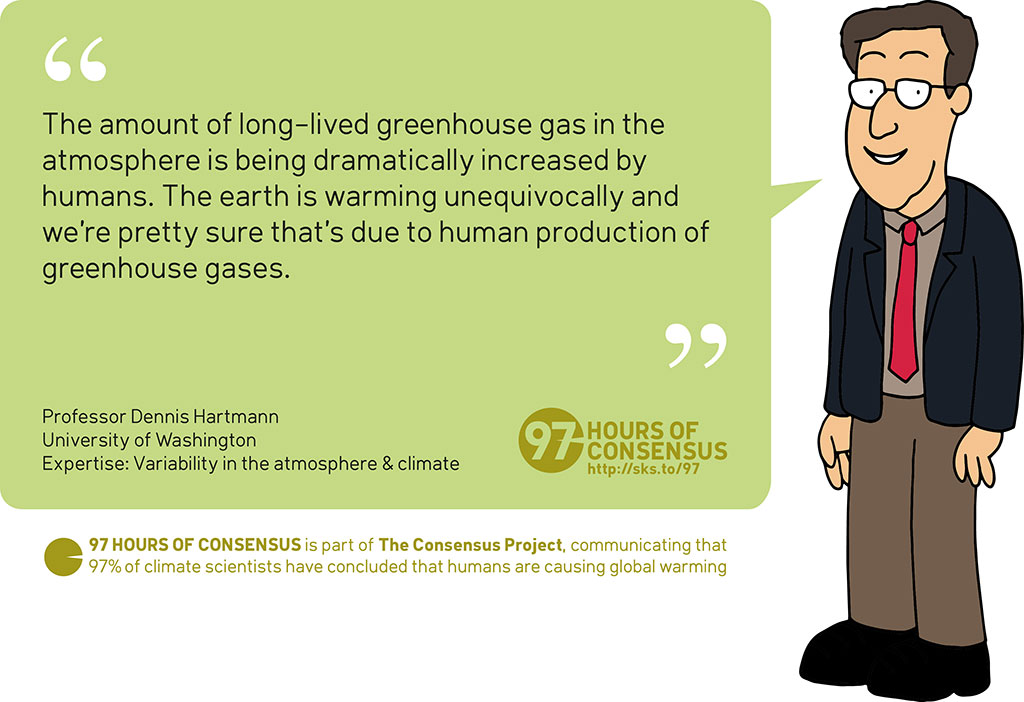2017 SkS Weekly Climate Change & Global Warming Digest #34
Posted on 27 August 2017 by John Hartz
Story of the Week... Opinion of the Week... Toon of the Week... Quote of the Week... SkS in the News... Video of the Week... Coming Soon on SkS... Poster of the Week... Climate Feedback Reviews... SkS Week in Review... 97 Hours of Consensus...
Story of the Week...
Why the IPA's claim global warming is natural is 'junk science'
 Participants at a 2015 UN climate conference look at a world map of rising global temperatures. Photograph: Stephane Mahe/Reuters
Participants at a 2015 UN climate conference look at a world map of rising global temperatures. Photograph: Stephane Mahe/Reuters
People who work for climate science denial thinktanks tend not to spend all that much time worrying about getting stuff into scientific journals.
Perhaps because it’s easier, people who are paid to tell the public and policy makers that human-caused climate change is overblown bunk would rather pump out newspaper columns, do softball interviews or push out their own self-published reports. There’s a lot less scrutiny in that kind of public relations.
So when two staffers at Australia’s Institute of Public Affairs managed to get some “science” into a journal earlier this month, there was much delight in conservative media outlets, together with a distinct lack of any genuine scepticism.
“Global Warming Is Almost Entirely Natural, Study Confirms,” wrote Breitbart. “Advanced Computer Models Suggest Most Global Warming Is From Natural Forces,” said the Daily Caller.
One of the authors, Jennifer Marohasy, took to the Spectator to claim her research had shown that recent global warming was almost entirely natural. The web traffic behemoth the Drudge Report also linked to Marohasy’s article.
None of the writers bothered to ask a single other genuine climate scientist for their view on the paper.
I asked five. They variously summarised the research as “junk science” and seriously flawed. Oh dear.
Why the IPA's claim global warming is natural is 'junk science' by Graham Readfearn, Planet Oz, Guardian, Aug 25, 2017
Opinion of the Week...

THE KNOCK ON ENVIRONMENTALISTS IS THAT THEY’VE BEEN BETTER AT OPPOSING THAN PROPOSING. Sure, being against overheating the planet or melting the ice caps should probably speak for itself—but it doesn’t give us a means. So it’s important news that the environmental movement seems to be rallying round a new flag. That standard bears a number: 100 percent.
It’s the call for the rapid conversion of energy systems around the country to 100 percent renewable power—a call for running the United States (and the world) on sun, wind and water. What Medicare for All is to the healthcare debate, or Fight for $15 is to the battle against inequality, 100% Renewable is to the struggle for the planet’s future. It’s how progressives will think about energy going forward—and though it started in northern Europe and Northern California, it’s a call that’s gaining traction outside the obvious green enclaves. In the last few months, cities as diverse as Atlanta and Salt Lake have taken the pledge.
No more half-measures. Barack Obama drove environmentalists crazy with his “all-of-the-above” energy policy, which treated sun and wind as two items on a menu that included coal, gas and oil. That is not good enough. Many scientists tell us that within a decade, at current rates, we’ll likely have put enough carbon in the atmosphere to warm the Earth past the Paris climate targets. Renewables—even the most rapid transition—won’t stop climate change, but getting off fossil fuel now might (there are no longer any guarantees) keep us from the level of damage that would shake civilization.
In any event, we no longer need to go slow: In the last few years, engineers have brought the price of renewables so low that, according to many experts, it would make economic sense to switch over even if fossil fuels weren’t wrecking the Earth. That’s why the appeal of 100% Renewable goes beyond the Left. If you pay a power bill, it’s the common-sense path forward.
Keep It 100 by Bill McKibben, In These Times, Aug 22, 2017/Sep Print Issue
Toon of the Week...

Quote of the Week...
From our good friends at ClimateNexus...
Celebrating a Decade of Debunking at Skeptical Science
We don’t normally celebrate birthdays here, but this one is worth a mention. Ten years ago, an Australian named John Cook decided to catalog denier myths for easy debunking after experiencing climate change skepticism in his own family. Not long after, he went public with the myth-busting and SkepticalScience.com was born.
To celebrate a decade of debunking, SKS contributor BaerbelW put together a year-by-year walkthrough of the site’s successes, and it’s an impressive showing of what a group of dedicated volunteers can accomplish. From the numbered database of Most Used Myths, to an iPhone and Android app that’s been downloaded tens of thousands of times, to a Guardian blog spin-off by two SKS contributors, to an open-source online class on countering climate denial, to a 97-hour event honoring scientists with fun cartoons, to the 97% consensus paper famously tweeted by Obama, and a consensus on the consensusfollow-up, the SKS crew has been unquestionably instrumental in pushing back on denial.
Two of our favorite resources, which we come back to time and again and recommend for everyone new to the space, are the Debunking Handbook and the Escalator graphic. The handbook is short but incredibly informative, while the Escalator gif is the most clear and concise rebuttal to the “pause” one could ask for.
Unfortunately, they have not yet worked themselves into obsolescence because deniers are still all too common. With the Red Team ramping up, and silly pseudo-science still kicking around, denial’s showing no signs of disappearing. But hopefully before too long there won’t be a need for the continued debunkings, as the realities of clean energy disprove denier myths where it really counts.
So happy 10th birthday, Skeptical Science, and here’s to hoping there won’t be any need for another 10 more!
SkS in the News...
John Cook is quoted in:
- It Turns Out That Knowing More About Science Doesn't Correct Misbelief by Kristen V. Brown, Aug 25, 2017
- Stop treating science denial like a disease by Daniel Sarewitz, Guardian, Aug 21, 2017
- People Furthest Apart on Climate Views Are Often the Most Educated by Umar Ifran, ClimateWire/Scientific American, Aug 21, 2017
Video of the Week...
Scientist Explains Climate Ice Core Proxies (2017)
On Thursday evening March 2, 2017, the Rutgers community was treated to an inspiring lecture by Dr. Lonnie G. Thompson, Distinguished University Professor in the Geological Sciences and Research Scientist at the Byrd Polar and Climate Research Center, The Ohio State University who spoke on Past, Present and Future of Glacier Archives from the World’s Highest Mountains.
Dr. Thompson’s research has propelled the field of ice core paleoclimatology out of the Polar Regions to the highest tropical and subtropical ice fields. He and his colleagues from Ohio State have developed lightweight solar-powered drilling equipment to acquire climate histories from ice fields all over the world including the tropical South American Andes, the Himalayas, and on Kilimanjaro.
The event was sponsored by Rutgers Institute of Earth, Ocean, and Atmospheric Sciences and co-sponsored by Rutgers Climate Institute and Rutgers University-New Brunswick America Converges Here.
Scientist Explains Climate Ice Core Proxies (2017), Climate State/YouTube Video, Aug 21, 2017
Coming Soon on SkS...
- Study: Katharine Hayhoe is successfully convincing doubtful evangelicals about climate change (Dana)
- I was an Exxon-funded climate scientist (Katharine Hayhoe)
- SkS Analogy 10 - Bathtubs and Budgets (Evan)
- Guest Post (John Abraham)
- Why the 97% climate consensus is important (Dana, John Cook, Sander van der Linden, Ed Maibach, Tony Lieserowitz)
- 2017 SkS Weekly Climate Change & Global Warming News Roundup #35 (John Hartz)
- 2017 SkS Weekly Climate Change & Global Waming Digest #35 (John Hartz)
Poster of the Week...

Climate Feedback Reviews...
Climate Feedback asked its network of scientists to review the article, Alaska's Permafrost is Thawing by Henry Fountain, New York Times, Aug 23, 2017
Five scientists analyzed the article and estimate its overall scientific credibility to be 'high' to 'very high'.
A majority of reviewers tagged the article as: Accurate, Insightful, Sound reasoning, and Unbiased.
Review Summary
This story in the New York Times looks at the thawing trend of permafrost (permanently frozen soil and sediment) in Alaska as the region warms due to climate change, and the potential for this landscape to be an additional source of greenhouse gases in the future, which would further amplify global warming.
Scientists who reviewed the article found that it accurately represented current research on the region, which shows that Alaska’s area of permafrost is shrinking as more and more ground thaws. This destabilizes the land surface, damaging buildings and infrastructure, and allows frozen organic matter to decay. Given the uncertainty in future projections of greenhouse gases released by thawing permafrost, however, providing more information than just the upper end of the range could help readers understand this feedback more clearly.
SkS Week in Review...
- 2017 SkS Weekly Climate Change & Global Warming News Roundup #34 by John Hartz
- New study finds that climate change costs will hit Trump country hardest by John Abraham (Climate Consensus - the 97%)
- Harvard scientists took Exxon’s challenge; found it using the tobacco playbook by Dana Nuccitelli (Climate Consensus - the 97%)
- It's Skeptical Science's 10th Birthday! by BaerbelW
- Solar eclipse: Why the sun is not responsible for recent climate change by Zeke Hausfather (Carbon Brief)
- 2017 SkS Weekly Climate Change & Global Warming Digest #33 by John Hartz
97 Hours of Consensus...

Dennis Hartmann's bio page and Quote source
High resolution JPEG (1024 pixels wide)































 Arguments
Arguments






























Regarding the IPA claims. Hard to believe anyone could produce such hopeless garbage, and and not be totally embarassed.
Anyway I thought the climate sceptics had a low opinion of "models". These people are so arrogant they think nobody can see their many contradictions.